egn
Adventurer
Blue Thunder is now a solar power station!
It is time for another update.
I have added some images about the cooler modification to my last post.
In 2011 there wasn't any change to the truck.
For vacation we went to Sweden and had a great time.
After our vacation I wanted finally decide regarding solar power installation. As I have mentioned in my last post, in 2010 I had changed the type of the modules from the flexible thin-film to glueable mono cristaline modules with a total of 1,680 Wp. But here had finally the same problem like with the Unisolar modules - they weren't available immediately and were considerable more expensive than nor modules. The prices of modules have dropped very fast here in Germany, with prices below 1 $/Wp for some modules. So I reconsidered my decision again, and looked for other modules, especially modules with measurements to maximize the power on the available roof area. I finally found modules that allowed 1,960 Wp on the roof for a reasonable price. I ordered them in China and in November 2011 they were delivered directly from China to me.

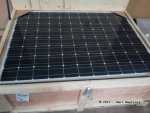
As the power now was much higher than the Morningstar could handle, I also needed a other solar charge controller. For fault tolerance I now use two Mppsolar PCM-5048 I ordered directly in Taiwan. They can run in master/slave mode and have nice features regarding controlling external relays depending on system state.


I installed them on top of the external power chargers. Finally I installed the modules on the roof.
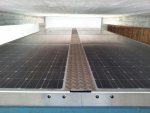
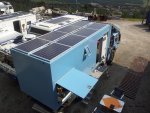
Everything is protected against tree branches as good as possible. Some will argue that there is very low cooling possible, because the distance between roof and panel is very low. But this isn't much of relevance, because in summer there is more then enough energy available, and in times with less sun the temperature isn't an issue and the extra Wp will help. I also didn't want to go higher than necessary, so the additional height is less than 2". In summer the surplus energy is used to electrically heat warm water.
The first test of the installation was end of June during a small offroad meeting in Meran, Italy (first image above) and everything worked perfectly. At temperatures of up to 38° C (100 F) it delivered about 6 kWh (250 Ah/24 V) per day, mostly for heating the warm water and electrical cooking.
Here you can see how everything is connected:
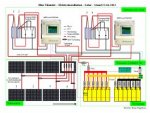
After this we fixed again some oil leaks at the engine. We had to replace the injection pump against my spare one, because it leaked considerable oil. The injections pump was also tuned to get a bit more power at revolutions below 2000, and it now feels much better when driving highway hills in highest gear.
Before our vacation another change was due - replacing the old 6 kW inverters against 6 kW true sine inverters. It wasn't easy to find one that had a reasonable price and fits into the available space. But I finally found it at a Chinese company and it was delivered within 2 weeks. The installation was easy.
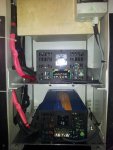
All the devices that are sensible to the wave form (microwave, coffee machine, ...) are now running without problems. As before it is enough to use only one inverter when cooking a meal.
Everything was ready for our vacation in Ireland in August. We had a great time in Ireland, even the roads were very narrow. :sombrero:
Even it was raining and we didn't move, the batteries were 100 % full every day at least once. The complete warm water was provided by the solar power.
Currently there are no plans for further changes in the near future, but who knows ...
It is time for another update.
I have added some images about the cooler modification to my last post.
In 2011 there wasn't any change to the truck.
For vacation we went to Sweden and had a great time.
After our vacation I wanted finally decide regarding solar power installation. As I have mentioned in my last post, in 2010 I had changed the type of the modules from the flexible thin-film to glueable mono cristaline modules with a total of 1,680 Wp. But here had finally the same problem like with the Unisolar modules - they weren't available immediately and were considerable more expensive than nor modules. The prices of modules have dropped very fast here in Germany, with prices below 1 $/Wp for some modules. So I reconsidered my decision again, and looked for other modules, especially modules with measurements to maximize the power on the available roof area. I finally found modules that allowed 1,960 Wp on the roof for a reasonable price. I ordered them in China and in November 2011 they were delivered directly from China to me.


As the power now was much higher than the Morningstar could handle, I also needed a other solar charge controller. For fault tolerance I now use two Mppsolar PCM-5048 I ordered directly in Taiwan. They can run in master/slave mode and have nice features regarding controlling external relays depending on system state.


I installed them on top of the external power chargers. Finally I installed the modules on the roof.


Everything is protected against tree branches as good as possible. Some will argue that there is very low cooling possible, because the distance between roof and panel is very low. But this isn't much of relevance, because in summer there is more then enough energy available, and in times with less sun the temperature isn't an issue and the extra Wp will help. I also didn't want to go higher than necessary, so the additional height is less than 2". In summer the surplus energy is used to electrically heat warm water.
The first test of the installation was end of June during a small offroad meeting in Meran, Italy (first image above) and everything worked perfectly. At temperatures of up to 38° C (100 F) it delivered about 6 kWh (250 Ah/24 V) per day, mostly for heating the warm water and electrical cooking.
Here you can see how everything is connected:

After this we fixed again some oil leaks at the engine. We had to replace the injection pump against my spare one, because it leaked considerable oil. The injections pump was also tuned to get a bit more power at revolutions below 2000, and it now feels much better when driving highway hills in highest gear.
Before our vacation another change was due - replacing the old 6 kW inverters against 6 kW true sine inverters. It wasn't easy to find one that had a reasonable price and fits into the available space. But I finally found it at a Chinese company and it was delivered within 2 weeks. The installation was easy.

All the devices that are sensible to the wave form (microwave, coffee machine, ...) are now running without problems. As before it is enough to use only one inverter when cooking a meal.
Everything was ready for our vacation in Ireland in August. We had a great time in Ireland, even the roads were very narrow. :sombrero:
Even it was raining and we didn't move, the batteries were 100 % full every day at least once. The complete warm water was provided by the solar power.
Currently there are no plans for further changes in the near future, but who knows ...
Last edited:


